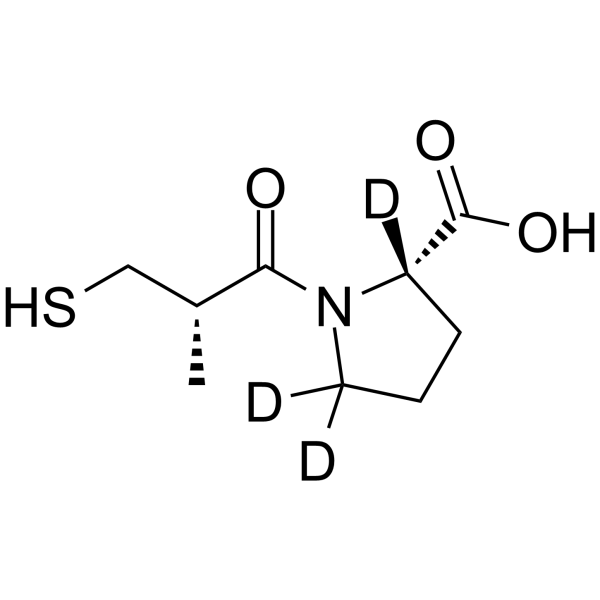Captopril-d3
Modify Date: 2025-08-26 16:47:43

Captopril-d3 structure
|
Common Name | Captopril-d3 | ||
|---|---|---|---|---|
| CAS Number | 1356383-38-4 | Molecular Weight | 220.30 | |
| Density | 1.3±0.1 g/cm3 | Boiling Point | 427.0±40.0 °C at 760 mmHg | |
| Molecular Formula | C9H12D3NO3S | Melting Point | N/A | |
| MSDS | N/A | Flash Point | 212.1±27.3 °C | |
Use of Captopril-d3Captopril-d3 is deuterium labeled Captopril. Captopril (SQ 14225), antihypertensive agent, is a thiol-containing competitive, orally active angiotensin-converting enzyme (ACE) inhibitor (IC50=0.025 μM) and has been widely used for research of hypertension and congestive heart failure. Captopril is also a New Delhi metallo-β-lactamase-1 (NDM-1) inhibitor with an IC50 of 7.9 μM[1][2][3]. |
| Name | 1-[(2S)-2-Methyl-3-sulfanylpropanoyl]-L-(2,5,5-2H3)proline |
|---|---|
| Synonym | More Synonyms |
| Description | Captopril-d3 is deuterium labeled Captopril. Captopril (SQ 14225), antihypertensive agent, is a thiol-containing competitive, orally active angiotensin-converting enzyme (ACE) inhibitor (IC50=0.025 μM) and has been widely used for research of hypertension and congestive heart failure. Captopril is also a New Delhi metallo-β-lactamase-1 (NDM-1) inhibitor with an IC50 of 7.9 μM[1][2][3]. |
|---|---|
| Related Catalog | |
| In Vitro | Stable heavy isotopes of hydrogen, carbon, and other elements have been incorporated into drug molecules, largely as tracers for quantitation during the drug development process. Deuteration has gained attention because of its potential to affect the pharmacokinetic and metabolic profiles of drugs[1]. |
| References |
| Density | 1.3±0.1 g/cm3 |
|---|---|
| Boiling Point | 427.0±40.0 °C at 760 mmHg |
| Molecular Formula | C9H12D3NO3S |
| Molecular Weight | 220.30 |
| Flash Point | 212.1±27.3 °C |
| Exact Mass | 220.096100 |
| LogP | 0.27 |
| Vapour Pressure | 0.0±2.2 mmHg at 25°C |
| Index of Refraction | 1.551 |
| InChIKey | FAKRSMQSSFJEIM-SIHDFBQLSA-N |
| SMILES | CC(CS)C(=O)N1CCCC1C(=O)O |
| 1-[(2S)-2-Methyl-3-sulfanylpropanoyl]-L-(2,5,5-2H3)proline |
| L-Proline-2,5,5-d3, 1-[(2S)-3-mercapto-2-methyl-1-oxopropyl]- |